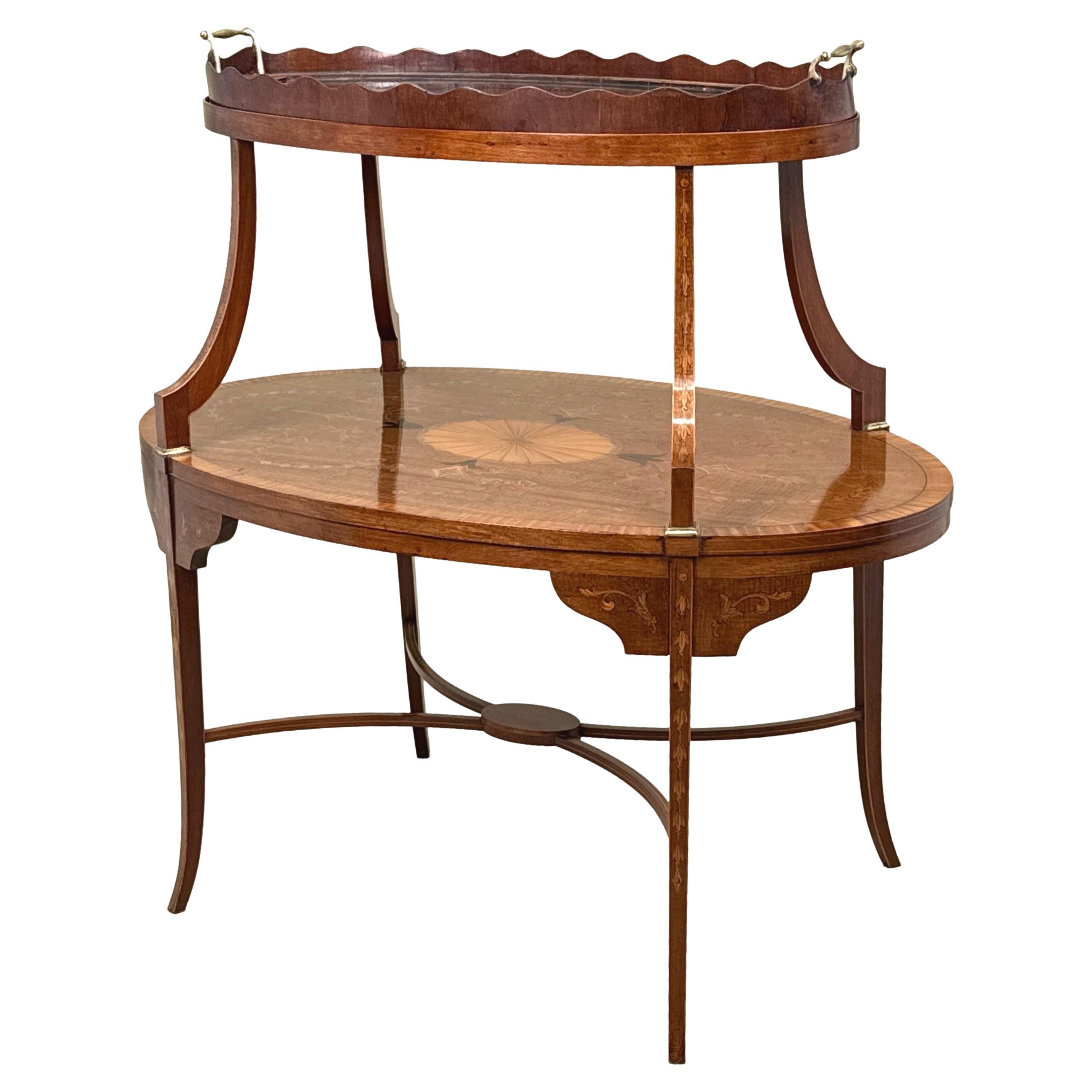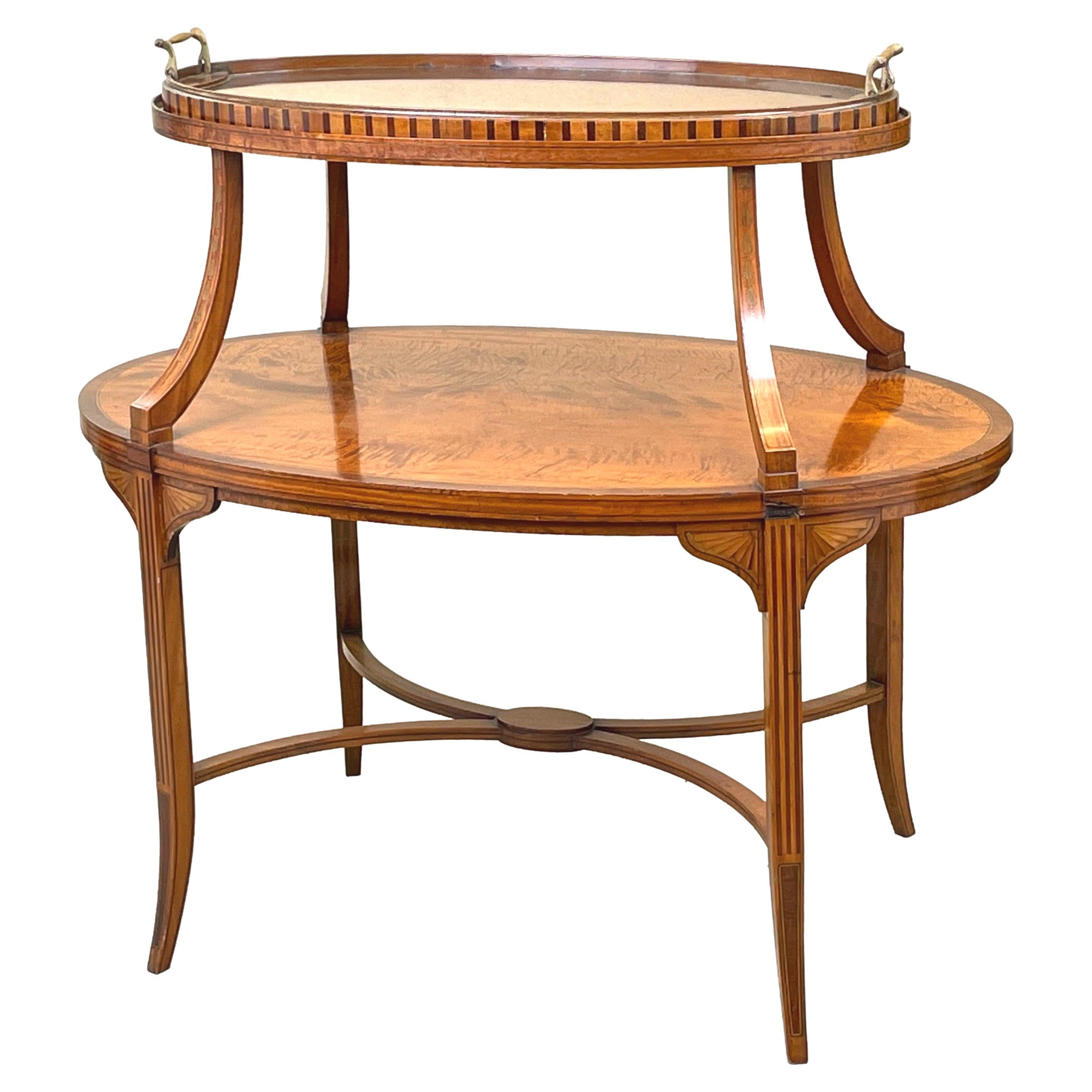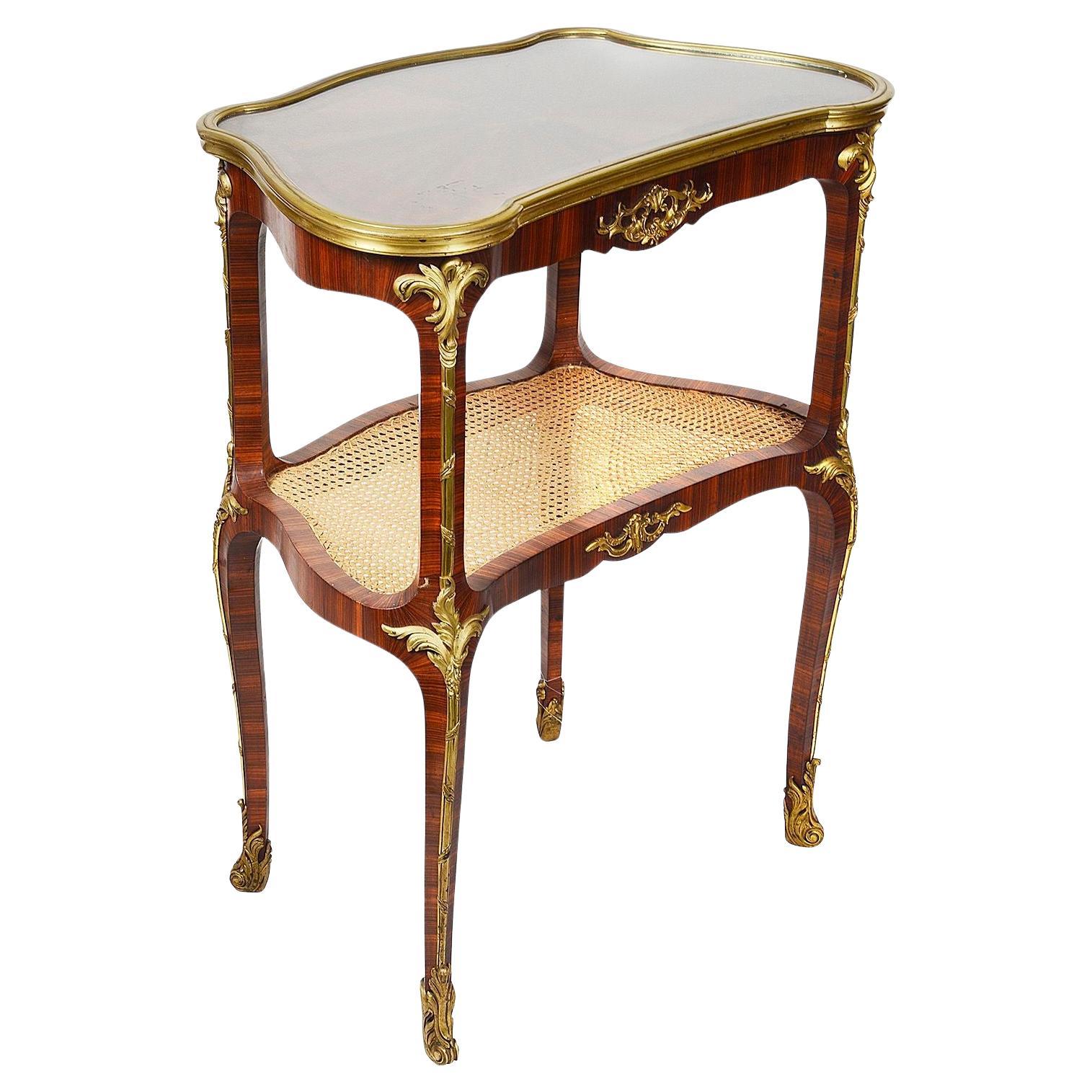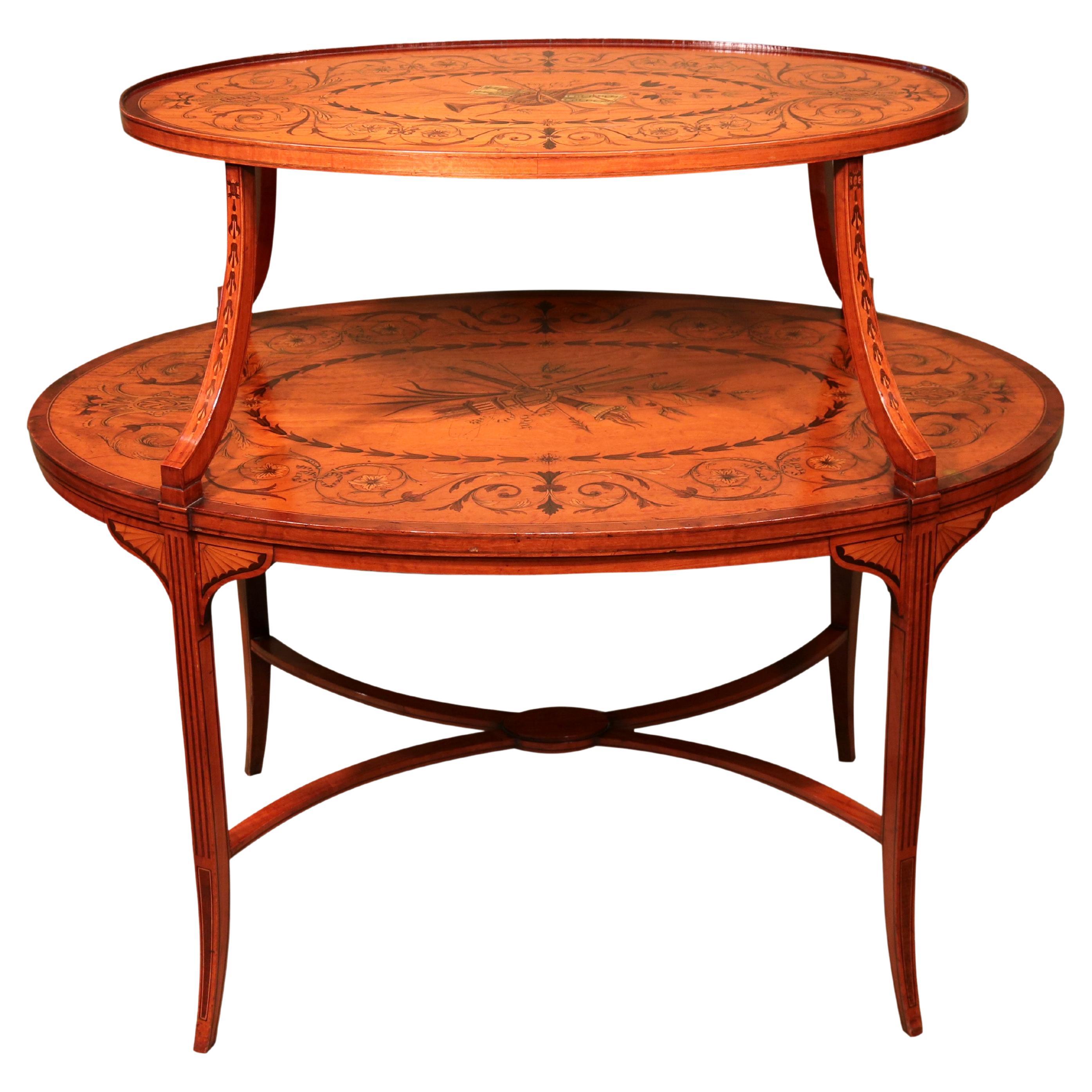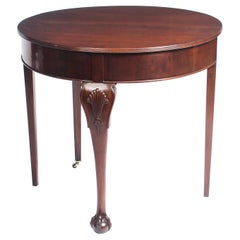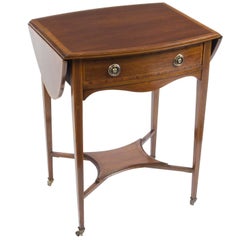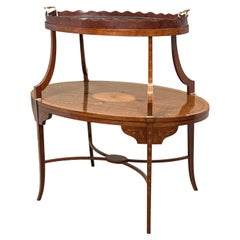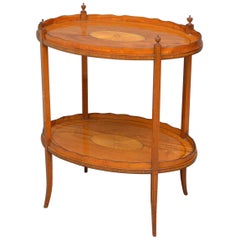Items Similar to 19th Century English Mahogany & Satinwood Etagere Tray Table
Video Loading
Want more images or videos?
Request additional images or videos from the seller
1 of 12
19th Century English Mahogany & Satinwood Etagere Tray Table
$2,409.39
£1,750
€2,061.24
CA$3,300.75
A$3,662.46
CHF 1,918.48
MX$44,911.60
NOK 24,402.35
SEK 23,034.78
DKK 15,371.94
Shipping
Retrieving quote...The 1stDibs Promise:
Authenticity Guarantee,
Money-Back Guarantee,
24-Hour Cancellation
About the Item
This is a truly exceptional antique English Edwardian mahogany and satinwood marquetry oval two tier 'etagere', in the manner of Edwards & Roberts, circa 1890 in date.
Crafted from the best flame mahogany, note the wonderful grain to the wood and the beautifully inlaid decoration with musical trophies within scrolling foliage and kingwood crossbanding.
Masterfully inlaid with Sheraton influences, this etagere has an elegant refined look.
The removable glass bottomed tray can be used to serve drinks, etc.
It is raised on elegant square section tapering outswept legs with a shaped cross stretcher.
The craftsmanship and finish are second to none.
THE BOTANICAL NAME FOR THE MAHOGANY THAT THIS ITEM IS MADE OF IS SWIETENIA MACROPHYLLA AND THIS TYPE OF MAHOGANY IS NOT SUBJECT TO CITES REGULATION AND DOES NOT CONTAIN ANY RESTRICTED MATERIALS.
Condition:
In excellent condition having been beautifully cleaned and waxed in our workshops, please see photos for confirmation.
Dimensions in cm:
Height 84 x Width 89 x Depth 55
Dimensions in inches:
Height 33.1 x Width 35.0 x Depth 21.7
Edwards & Roberts
was founded in 1845, and had premises at 21 Wardour Street London. By the 1892 they occupied more than a dozen buildings in Wardour Street, where they continued to trade until the end of the century.
They became one of the leading London cabinet makers and retailers working in a variety of styles, both modern and revivalist. Their business also involved retailing, adapting and restoring the finest antique furniture and there are many examples of their earlier furniture with later embellishments bearing their stamp.
Edwards & Roberts specialised in marquetry, inlay and ormolu.
Marquetry is decorative artistry where pieces of material (such as wood, pewter, or brass silver) of different colours are inserted into surface wood veneer to form intricate patterns such as scrolls or flowers.
The technique of veneered marquetry had its inspiration in 16th century Florence. Marquetry elaborated upon Florentine techniques of inlaying solid marble slabs with designs formed of fitted marbles, jaspers and semi-precious stones. This work, called opere di commessi, has medieval parallels in Central Italian "Cosmati"-work of inlaid marble floors, altars and columns. The technique is known in English as pietra dura, for the "hardstones" used: onyx, jasper, cornelian, lapis lazuli and colored marbles. In Florence, the Chapel of the Medici at San Lorenzo is completely covered in a colored marble facing using this demanding jig-sawn technique.
Techniques of wood marquetry were developed in Antwerp and other Flemish centers of luxury cabinet-making during the early 16th century. The craft was imported full-blown to France after the mid-seventeenth century, to create furniture of unprecedented luxury being made at the royal manufactory of the Gobelins, charged with providing furnishings to decorate Versailles and the other royal residences of Louis XIV. Early masters of French marquetry were the Fleming Pierre Golle and his son-in-law, André-Charles Boulle, who founded a dynasty of royal and Parisian cabinet-makers (ébénistes) and gave his name to a technique of marquetry employing brass with pewter in arabesque or intricately foliate designs.
Etagère is a piece of light furniture which was extensively made in France during the latter part of the 18th century. It consists of a series of stages or shelves for the reception of ornaments or other small articles. Like the what-not it was very often cornerwise in shape, and the best Louis XVI examples in exotic woods are exceedingly graceful and elegant.
In modern usage, an étagère is often used to refer specifically to a long-legged shelf unit that fits over a bathroom toilet, also known as a space saver.
Our reference: 08701
- Dimensions:Height: 33.08 in (84 cm)Width: 35.04 in (89 cm)Depth: 21.66 in (55 cm)
- Style:Edwardian (Of the Period)
- Materials and Techniques:
- Place of Origin:
- Period:
- Date of Manufacture:circa 1890
- Condition:
- Seller Location:London, GB
- Reference Number:Seller: 087011stDibs: LU95069662261
About the Seller
5.0
Platinum Seller
Premium sellers with a 4.7+ rating and 24-hour response times
Established in 1983
1stDibs seller since 2012
1,371 sales on 1stDibs
Typical response time: <1 hour
Associations
LAPADA - The Association of Arts & Antiques Dealers
- ShippingRetrieving quote...Shipping from: London, United Kingdom
- Return Policy
Authenticity Guarantee
In the unlikely event there’s an issue with an item’s authenticity, contact us within 1 year for a full refund. DetailsMoney-Back Guarantee
If your item is not as described, is damaged in transit, or does not arrive, contact us within 7 days for a full refund. Details24-Hour Cancellation
You have a 24-hour grace period in which to reconsider your purchase, with no questions asked.Vetted Professional Sellers
Our world-class sellers must adhere to strict standards for service and quality, maintaining the integrity of our listings.Price-Match Guarantee
If you find that a seller listed the same item for a lower price elsewhere, we’ll match it.Trusted Global Delivery
Our best-in-class carrier network provides specialized shipping options worldwide, including custom delivery.More From This Seller
View AllAntique Sheraton Revival Satinwood Centre Occasional Table Circa 1900
Located in London, GB
This is a magnificent superb quality antique English Edwardian Sheraton Revival satinwood centre table, circa 1900 in date.
This splendid circular centre table is beautifully crossb...
Category
Antique Early 1900s Side Tables
Materials
Satinwood
Antique Victorian Mahogany Demilune Card Console Tea Table, 19th Century
Located in London, GB
This is a beautiful antique Victorian mahogany demi lune side table, 19th century in date.
The table is made of solid mahogany with a moulded top above a plain frieze and is raised ...
Category
Antique 1850s English Victorian Card Tables and Tea Tables
Materials
Mahogany
Early 20th Century Edwardian Inlaid Occasional Table
Located in London, GB
This is a delightful antique Edwardian mahogany and inlaid and crossbanded occasional table, circa 1900.
This is a drop-leaf table which has a useful drawer with two brass handles. ...
Category
Antique Early 1900s English Edwardian Side Tables
Materials
Mahogany
Antique Victorian Mahogany & Inlaid Nest of 3 Tables 19th Century
Located in London, GB
This is a beautiful antique Edwardian mahogany and inlaid nest of tables, circa 1880 in date.
The nest consists of a set of three matching interlocking tables, each has a rich flam...
Category
Antique 1880s English Edwardian Side Tables
Materials
Mahogany
Antique French Louis Revival Marqutry Ormolu Occasional Table 19th Century
Located in London, GB
This is a beautiful antique French Louis Revival marquetry and ormolu mounted walnut and king wood serpentine side table, circa 1850 in date.
The beautiful shaped marquetry top is ...
Category
Antique 1850s French Revival Side Tables
Materials
Ormolu
Antique Mahogany and Satinwood Inlaid Serpentine Card Console Table 19th Century
Located in London, GB
This is a superb antique mahogany serpentine fold-over card table, circa 1880 in date.
This splendid card table is made of the finest quality mahogany and features a hinged foldover shaped top with a demi-lune motif of fanned satinwood & green stained hare-wood surrounded by radial spurs of bell-flowers between swagged bands, bordered with satinwood cross-banding outlined with stringing.
The frieze inlaid with fluting and having a bow front drawer to the centre adorned with swagged bell-flower chains, with further pendant garlands leading down the square tapering legs on spade feet.
The quality and attention to detail throughout are second to none.
THE BOTANICAL NAME FOR THE MAHOGANY THAT THIS CARD TABLE IS MADE OF IS SWIETENIA MACROPHYLLA AND THIS TYPE OF MAHOGANY IS NOT SUBJECT TO CITES REGULATION.
Condition:
In excellent condition having been beautifully cleaned, polished and waxed in our workshops and the baize relined, please see photos for confirmation.
Dimensions in cm:
Height 78 x Width 92 x Depth 47
Dimensions in inches:
Height 2 foot, 7 inches x Width 3 foot x Depth 1 foot, 6 inches
Satinwood
is a hard and durable wood with a satinlike sheen, much used in cabinetmaking, especially in marquetry. It comes from two tropical trees of the family Rutaceae (rue family). East Indian or Ceylon satinwood is the yellowish or dark-brown heartwood of Chloroxylon swietenia.
The lustrous, fine-grained, usually figured wood is used for furniture, cabinetwork, veneers, and backs of brushes. West Indian satinwood, sometimes called yellow wood, is considered superior. It is the golden yellow, lustrous, even-grained wood found in the Florida Keys...
Category
Antique 1880s Card Tables and Tea Tables
Materials
Mahogany, Satinwood
You May Also Like
Fine 19th Century Mahogany & Satinwood Two Tier Table
Located in Bedfordshire, GB
A Very Fine Quality Late 19th Century Mahogany And Satinwood Oval Two Tier Etagere, Dumb Waiter, Or Occasional Table, Having Removable Glass Tray With Wavy Galleried Edge To Top, Rai...
Category
Antique Late 19th Century English Edwardian End Tables
Materials
Mahogany, Satinwood
$5,066 Sale Price
20% Off
Late Victorian Satinwood Tray Table
Located in Whaley Bridge, GB
Sn4484, late Victorian satinwood tray table of oval form with two-tier decorated with sunburst inlays and solid shaped gallery with turned finials, standing on slender, string inlaid...
Category
Antique 1890s English Late Victorian Tray Tables
Materials
Satinwood
$2,037 Sale Price
20% Off
19th Century Satinwood Oval Étagère
Located in Bedfordshire, GB
A fine quality late 19th century satinwood oval two tier etagere, or dumbwaiter, having removable lift off glass tray top and superbly figured veneers with crossbanded and inlaid dec...
Category
Antique Late 19th Century English Edwardian Tray Tables
Materials
Satinwood
$3,028 Sale Price
20% Off
French Mahogany two tier Etagere, circa 1890
Located in Brighton, Sussex
A very good quality French late 19th Century mahogany two tier Etagere, having a wonderful segmented, radiated veneered top, gilded ormolu mounts and a cane under-tier, raised on scr...
Category
Antique 19th Century French End Tables
Materials
Ormolu
Mahogany and Marquetry-Inlaid Two-Tier Étagère -Edwards & Roberts
By Edwards and Roberts
Located in Altrincham, GB
Edwards & Roberts: A Mahogany and Marquetry-Inlaid Two-Tier Étagère, early 20th century, of graduated oval form, inlaid with musical trophies, husks and scrolling foliage, on slender...
Category
Antique Early 1900s English Edwardian Serving Tables
Materials
Satinwood
Edwardian Satinwood Two Tier Etargere
Located in London, GB
A two tier Edwardian period satinwood oval etagere, beautifully inlaid with a variety of exotic woods. The top tier has a removable two-handled tray.
Category
Early 20th Century English Edwardian Side Tables
Materials
Satinwood
More Ways To Browse
French 16th Table
Antique English Pewter
Italian 16th Century Table
Boulle 18th Century
16th Century Italian Cabinet
Flemish Cabinet
Marble Altar
Antique Stone Slabs
Pietra Dura Table Antique
Antwerp Cabinet
Onyx Cross
Trophy Cabinet
Antique Altar Cabinet
Hardstone Flower
English Drinks Tables
19th Century Pietra Dura Tables
Antique Pewter Cabinet
English Silver Tray Tables
